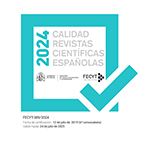Crisis y tragedia en el Barroco. A propósito de Gracián, Cervantes y el Neobarroco hispanoamericano
Resumen
El trabajo analiza el vínculo entre el Barroco hispano y el espíritu trágico. De acuerdo con el autor, lo trágico es articulado como tensión entre facticidad e idealidad, equivalente a la que existe entre “nada” y “todo”. El mundo es, al unísono, todo, porque la unidad integral de la diferencia que lo constituye está fundada en lo divino-infinito, y nada, porque dicho todo se ha refugiado en lo divino infinito. Lo trágico, según el autor, está ligado, así, a la figura filosófica de una “presencia de lo ausente”, modo de aparecer lo infinito en lo finito. La crisis barroca reside en esta fisura trágica y, en virtud de ella, en la lucha del ser humano contra poderes indisponibles que reducen el ser diferencial del mundo a una identidad vacua de este consigo mismo. Distingue el autor entre el modelo de la tragedia moral (Gracián) y el de la tragedia de la libertad (el Quijote cervantino). Es este último el que reverbera en el Neobarroco hispanoamericano, piensa el autor
Descargas
Descarga artículo
Licencia
La revista Res Publica. Revista de Historia de las Ideas Políticas, para fomentar el intercambio global del conocimiento, facilita el acceso sin restricciones a sus contenidos desde el momento de su publicación en la presente edición electrónica, y por eso es una revista de acceso abierto. Los originales publicados en esta revista son propiedad de la Universidad Complutense de Madrid y es obligatorio citar su procedencia en cualquier reproducción total o parcial. Todos los contenidos se distribuyen bajo una licencia de uso y distribución Creative Commons Reconocimiento 4.0 (CC BY 4.0). Esta circunstancia ha de hacerse constar expresamente de esta forma cuando sea necesario. Puede consultar la versión informativa y el texto legal de la licencia.









